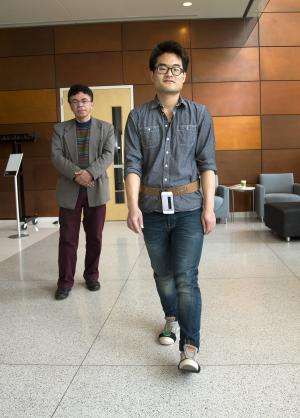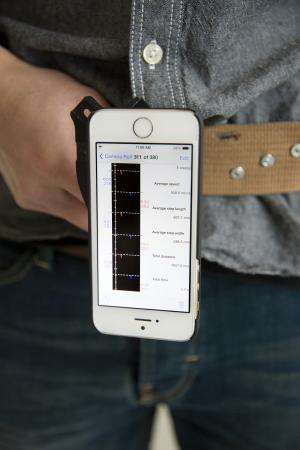Smartphone adapted to measure person's gait, reduce falls

Researchers have shown how to modify a smartphone so that it can be used to measure a person's walking gait to prevent falls in people with compromised balance, such as the elderly or those with Parkinson's disease.
The innovation, being commercialized as SmartGait, is designed as a tool to aid health care officials in assessing a person's risk of falling and identifying ways to avoid injury.
"We know that people who are more likely to fall have slower gait speeds and variable stride time, step length and step width. But it's hard to gather that information in an everyday environment," said Shirley Rietdyk, an associate professor in Purdue University's Department of Health and Kinesiology and a faculty associate with Purdue's Center on Aging and the Life Course.
The new system captures the gait length - the distance from the tip of the front foot to the tip of the back foot - and the gait width, the distance between each foot, and walking speed, said Babak Ziaie, a professor in the School of Electrical and Computer Engineering and Weldon School of Biomedical Engineering.
Until now, there has been no portable user-friendly system that could be worn for a period of time to record a person's gait, said Ziaie, who is working on SmartGait with Rietdyk, doctoral student Albert Kim and graduate student Junyoung (Justin) Kim.
The researchers adapted a conventional smartphone with a downward-looking wide-angle lens and a special app that allows the phone to record and calculate gait measurements. The smartphone is worn on the waist, and the system records a person's gait by measuring the distance between colored "foot markers" attached to the tip of each shoe.

Findings will be detailed in a paper to be presented during the International Society for Posture & Gait Research 2014 World Congress from June 29 to July 3 in Vancouver, Canada. The paper was authored by Albert Kim, Justin Kim, Rietdyk and Ziaie. Research findings also will be presented during the 7th World Congress of Biomechanics on July 6-11 in Boston.
The researchers compared SmartGait's performance with that of a laboratory system that uses sensors and infrared-emitting diodes to measure gait. Compared to this gold standard, findings indicate the system calculates step length with an accuracy of about 95 percent. The method was shown to have a step width accuracy of about 90 percent.
"The beauty of SmartGait is that it gives you results similar to a system that costs several tens of thousands of dollars," Ziaie said. "People can wear it walking upstairs, downstairs, outside, shopping, whatever they do during a normal day."
A U.S. patent application has been filed through the Purdue Office of Technology Commercialization.
Health care professionals could use data from SmartGait to make an assessment and recommend fall-prevention measures such as exercise, physical therapy or vision correction. The device also might be worn over time to gauge a patient's progress in walking confidently.
People 65 and older are America's fastest-growing population, a category particularly at risk for falls. In 2010 about 21,700 older adults died from unintentional fall injuries, and 2.3 million nonfatal fall injuries among older adults were treated in emergency departments.
"Reducing the fall rate has so many benefits – preventing injuries, minimizing pain, maintaining independence and saving lives," Rietdyk said.
Among the elderly, falls are a leading cause of both fatal and nonfatal injuries. Fear of falling again can prompt behavior changes that lead to reduced mobility or loss of fitness, which increases the risk of falling.
"I was interested in this area of research because my grandfather fell and broke his hip, and then he succumbed to his injuries and died," Ziaie said. "We believe this device will be highly beneficial for researchers and clinicians who conduct gait assessments in the field."
More information: Paper: Field assessment of gait: Accurate measures of step length and step length variability provided with a simple, inexpensive device, Albert Kim, Junyoung Kim, Shirley Rietdyk, and Babak Ziaie, International Society for Posture & Gait Research 2014 World Congress.
Provided by Purdue University


















